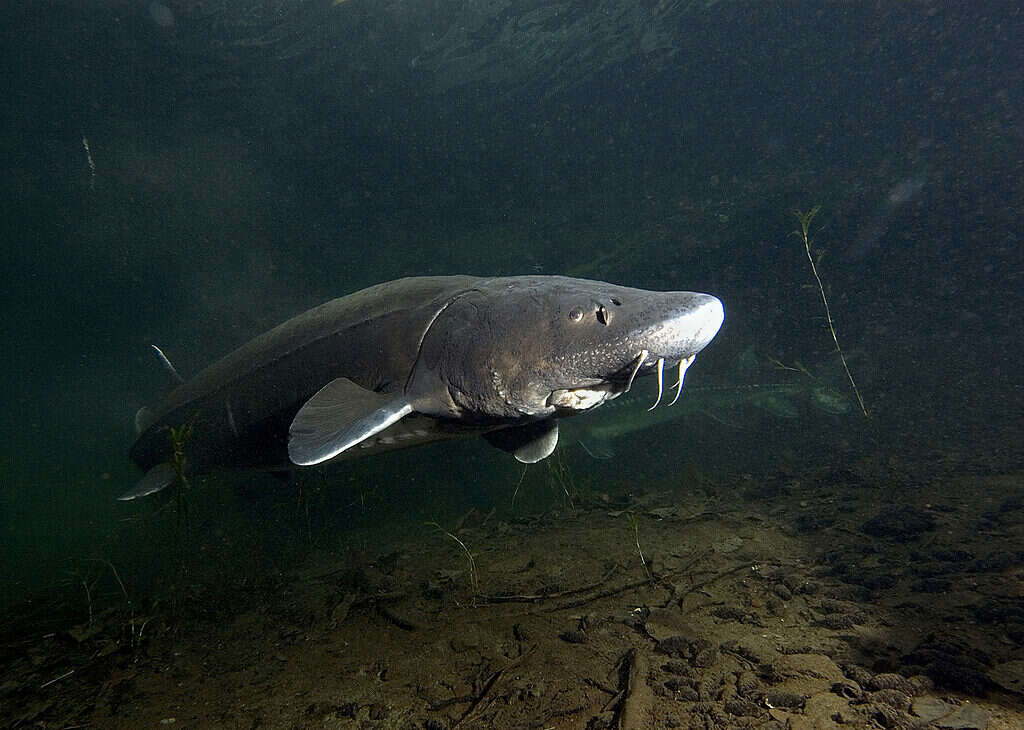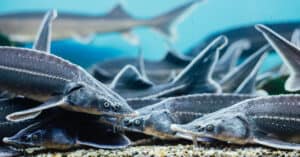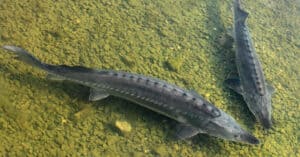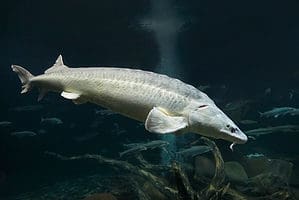If you’ve ever seen a white sturgeon in person, you likely will never forget it! These massive fish look like ancient dinosaurs of freshwater lakes around North America. Fishing for these big fish is no easy task either. Their size makes them a real contender, which is why they are so popular among fishermen.
So what was the largest sturgeon ever caught? How about the largest white sturgeon ever caught in Idaho? This guide will break down the answers and more.
What Is White Sturgeon?
The white sturgeon, or Acipenser transmontanus as it is known scientifically, is an intriguing species of fish that is a member of the Acipenseridae family. Some individuals can reach up to 20 feet long and weigh over 1,500 pounds. It is one of the biggest freshwater fish in North America.
The white sturgeon has a flattened head and an elongated body. It has rows of bony plates called scutes that run along its back and flanks. It differs from the majority of other fish species in that it has a distinctive cartilaginous skeleton and no actual bones. Its color, which ranges from dark gray to black on its dorsal side to pale gray to white on its ventral side, effectively conceals it in its environment.
White Sturgeon Habitat
These amazing fish are found from the Aleutian Islands in Alaska to Baja, California in Mexico. It is found in the rivers and estuaries along North America’s Pacific coast. They can live in freshwater and brackish water settings and have an amazing capacity for environmental adaptation. Large rivers, deep pools, and the lowest portions of estuaries are among the deep, still waters that white sturgeon favor.
White Sturgeon Diet
White sturgeon are bottom feeders, and they use their large snout and sensitive barbels to find food. Small fish, crustaceans, mollusks, and aquatic insects make up the majority of their food. They consume by rapidly extending their jaws, generating a vacuum that pulls prey into their mouths, a process known as suction feeding.
White Sturgeon Life Cycle
The white sturgeon’s life cycle can last for several decades and is extremely amazing. Some members of their long-living species live to be over 100 years old. White sturgeon mature slowly; males normally attain sexual maturity between the ages of 10 and 17, and females between the ages of 15 and 25. They often move to their natal rivers to breed in the spring or early summer after spawning. Hundreds of thousands of eggs are released into the water by the females, and sperm is also released at the same time by the males. After being externally fertilized, the eggs hatch, and the larvae float downstream until they find shallow places to grow safely.
White Sturgeon Conservation
White sturgeon migrate widely during their lives, alternating between freshwater and saltwater habitats. In quest of food, proper breeding sites, or ideal temperature ranges, they frequently traverse great distances. However, human actions like dams, pollution, and overfishing have severely hampered their amazing migratory pattern. The white sturgeon population has drastically decreased as a result, and it is currently thought to be a threatened species.
Through habitat restoration, fishing regulations, and the development of fish passage facilities, efforts are being undertaken to protect and restore white sturgeon populations. In order to create efficient conservation measures, research and monitoring programs strive to acquire data about their ecology, behavior, and population dynamics.
A fascinating fish species with significant ecological and cultural significance is the white sturgeon. It captures the attention of anyone that comes across it with its remarkable size, distinctive features, and long existence. It is essential to safeguard the existence of this iconic species so that future generations can appreciate and respect it. This can be done by protecting their habitat and putting sustainable management techniques in place.

While the white sturgeon (pictured) isn’t endangered, conservation efforts are still used to manage their numbers.
©Thesupermat, CC BY-SA 4.0 <https://creativecommons.org/licenses/by-sa/4.0>, via Wikimedia Commons – License
Typical Size of White Sturgeon
Before we dive into the largest white sturgeon caught in Idaho, it helps to understand the average size of these creatures. As the biggest freshwater fish species in North America, the white sturgeon is renowned for its remarkable size. Both scientists and amateur fishers are enthralled by these fascinating creatures because they have the capacity to reach enormous lengths and weights.
Adult white sturgeon are typically between seven and 12 feet long. However, some specimens have been measured to reach taller over 20 feet, making them actual aquatic giants. Given that they were obtained in freshwater conditions, these lengths are astounding.
White sturgeon are similarly massive in terms of weight. An adult white sturgeon typically weighs between 200 and 800 pounds. There have been cases of white sturgeon specimens weighing more than 1,500 pounds.
Size Difference Between Males and Females
Male and female white sturgeon are noticeably different in size. On average, females are often bigger than males. White sturgeon females may grow to be 12 to 20 feet long and weigh 800 to 1,500 pounds. Male white sturgeon, on the other hand, is normally between seven and 12 feet long and weigh between 100 and 300 pounds.
The size of white sturgeon can vary based on a number of variables, including the climate, the availability of food, and an individual sturgeon’s genetic makeup. Their enormous stature is also a result of their sluggish growth rate and late maturity, which gives them more time to put on weight and length over the course of their extended lifespans, which can surpass 100 years.
For recreational fishermen, white sturgeon are a highly sought-after species due to their extraordinary size, which adds to their attraction and mystique. However, strong laws are in place to safeguard them because of their vulnerable status and conservation concerns. To guarantee the preservation of this iconic species for future generations to enjoy, these laws frequently include size restrictions and catch-and-release procedures.
The History of Fishing for White Sturgeon
The history of white sturgeon fishing in North America spans several centuries and is entwined with the growth of the continent. Indigenous peoples were the first to fish for sturgeon because they understood the importance of these extraordinary fish as a food source and for many other purposes.
Sturgeon was important to the culture and way of life of Native American tribes that lived around the Pacific coast. They used a variety of fishing gear, including spears, nets, and weirs, to catch sturgeon. Sturgeons were treasured both for their skin (which was used for clothing and other uses) as well as for their meat. Sturgeon remnants have been discovered at many archaeological sites, underscoring the long history of indigenous societies’ use of these fish.
Commercial Sturgeon Fishing
Commercial sturgeon fishing started to take shape once European settlers arrived, and the fishing business expanded. White sturgeon populations were thriving in the major rivers around the Pacific coast in the late 19th and early 20th centuries, especially the Columbia River. Commercial fishing activities for white sturgeon increased as a result.
Sturgeon were largely taken at this time for their highly prized and sought-after caviar, which was sold in European markets. Due to their vast training and expertise in the caviar industry, immigrants from Eastern Europe, notably Russia, were crucial to the sturgeon fishing industry. The meat of the sturgeon was frequently discarded or utilized for other things, while the eggs were collected and made into caviar.
White sturgeon populations were negatively impacted by commercial fishing, habitat modification, and the building of dams. Throughout the 20th century, overfishing and a lack of control caused a significant drop in the number of sturgeon. Regulations were progressively implemented to safeguard sturgeon populations and guarantee their survival as it became clear that conservation was necessary.
Are White Sturgeon Endangered Due to Fishing?
No, but their populations are still protected. White sturgeon fishing is carefully controlled and regulated nowadays. Sturgeon populations have been protected and allowed to recover through the implementation of size restrictions, catch-and-release regulations, and seasonal closures. White sturgeon sport fishing has grown in popularity, drawing fishermen from all over the world who are looking for the excitement of capturing these gigantic fish.
The conservation and rehabilitation of sturgeon has received more attention in recent years. To better understand their requirements and create successful conservation plans, biologists and researchers are investigating sturgeon populations, their habitats, and their reproductive habits. These programs seek to safeguard the long-term survival of sturgeon populations by bringing them back to healthy levels.
In North America, fishing for white sturgeon has changed from being an industry that exploited resources with little concern for sustainability to one that is controlled and managed with a conservation mindset. It acts as a reminder of the value of ethical fishing methods and the necessity of safeguarding and conserving our natural resources for the next generations. We can expect to sustain healthy populations of white sturgeon and continue to appreciate these wonderful creatures for years to come by finding a balance between fishing possibilities and conservation activities.

White sturgeon (pictured) are popular among anglers and fishermen today.
©Oregon Department of Fish & Wildlife, CC BY-SA 2.0 <https://creativecommons.org/licenses/by-sa/2.0>, via Wikimedia Commons – License
The History of Fishing for Sturgeon in Idaho
The Snake River and the Clearwater River have a long history of hosting white sturgeon fishing in Idaho. White sturgeon have long been a component of Idaho’s aquatic ecology, and both settlers and indigenous peoples have benefited from their existence.
Native American tribes of Idaho, including the Nez Perce, used the rivers and the sturgeon that lived in them for food and cultural purposes. They used conventional fishing techniques like netting and spearing to catch sturgeon since they understood how valuable these fish were as a source of food.
Commercial white sturgeon fishing began in Idaho in the 19th century with the advent of European immigrants. The growth of transportation infrastructure and the building of dams made access to sturgeon habitats easier. Specifically, the Snake River developed into a key location for sturgeon fishing.
The Peak of Sturgeon Fishing in Idaho
Early in the 20th century, white sturgeon commercial fishing peaked. More so than their meat, the fish were coveted for their highly sought-after caviar. Since the caviar industry attracted immigrants with knowledge of caviar production, Idaho’s fishing sector has grown.
The Idaho white sturgeon population, however, suffered from overfishing and habitat loss, which resulted in a reduction in its numbers. The state implemented measures to save sturgeon and rebuild their numbers in response to conservation concerns. To encourage sustainable fishing techniques, size restrictions, fishing restrictions, and catch-and-release regulations were put into place.
In Idaho today, white sturgeon fishing is highly controlled and monitored. Sturgeon sport fishing has gained popularity and draws fishermen who like the rush of snagging these big, strong fish. Anglers can take pleasure in the activity while reducing their negative effects on the sturgeon population by using the catch-and-release method. As of today, it is illegal to harvest white sturgeon in the state of Idaho.
The Largest White Sturgeon Ever Caught in Idaho
The largest white sturgeon ever caught in Idaho were both caught in separate ways. The smaller of the winners was caught by Glenn Howard using a rod and reel. This monster of a fish from Snake River weighed in at 394 pounds. Its length and width were not recorded.
That was the largest white sturgeon ever caught in Idaho with a rod and reel. The largest ever white sturgeon ever caught in Idaho was caught with a set line, which makes perfect sense. There isn’t a rod and reel that could handle this massive beast. The record-breaker was caught in Snake River by an anonymous angler and weighed in at an astonishing 675 pounds. That’s a testament to the size of white sturgeon in Idaho!
Another fish worth mentioning would be the 10-foot monster of a white surgeon that was recently caught at the C.J. Strike Reservoir. This massive fish was caught by Angie and Greg Poulsen, who caught and released the fish shortly after. The weight of the fish was not measured.
Where is the Snake River Located on a Map?
The Snake River in Idaho is a prominent waterway that stretches approximately 1,078 miles through the northwestern regions of the United States. It originates from Yellowstone National Park and flows through Wyoming, southern Idaho, Oregon, and Washington before emptying into the Columbia River at its mouth near Pasco, Washington.
To locate the river on a map, one can easily identify it as it runs almost parallel to Interstate 84 throughout much of southern Idaho. Additionally, there are several major cities that lie along its banks, including Twin Falls and Boise. The river’s path is also punctuated by several dams and hydroelectric power plants, such as Hells Canyon Dam.
Despite being an integral part of Idaho’s landscape for centuries- providing irrigation for crops all over Southern Idaho -the Snake River has faced controversy due to various issues like pollution impacting fish populations or damming flowing waterways preventing salmon migration upstream which have led to calls to remove these structures.
Overall though, when looking at the snake river on a map or experiencing it first hand with activities such as rafting or fishing, this iconic body of water serves not only as an important resource but also offers breathtaking views with rugged terrain flanking much of its course.
The Largest White Sturgeon Ever Caught in the World
There are stories abound of behemoth white sturgeon weighing 1,500 to 2,000 pounds, including an enormous one-ton white sturgeon rumored to have been stuffed and on exhibit at the Chicago World’s Fair in 1893. Aside from urban legends, there isn’t much accurate or reliable information available concerning the biggest white sturgeon ever captured.
On the Fraser River in British Columbia, Canada, in 2021, Kevin Estrada and his boat passengers caught and tagged what is thought to be the biggest sturgeon ever seen caught on a rod and reel. The fish was thought to be older than 100 years. The fish’s length was 11 feet and six inches, and its pectoral girth was 55 inches.
The Fraser River in British Columbia is where novice anglers Steve Ecklund and Mark Boise captured one of the biggest white sturgeon ever as well. This river is a well-known stream that is home to many white sturgeon. There was a two-hour fight between the 10-foot, one-inch giant and the couple. The trip’s guides calculated that the fish weighed more than 700 pounds and was probably older than 100 years.
Steve Kaye, a guide on the Fraser River, has taken many fishermen to catch large fish. But one of the largest was one he hooked himself while on a charter trip in May of 2016. The 11-foot white sturgeon took two hours of effort to catch, according to Kaye, and he almost lost it when his reel handle broke. The sturgeon measured 11 feet and four inches in length and had a 54-inch girth. It was thought to weigh 750 pounds.
The Largest Sturgeon Officially Recorded
The largest white sturgeon ever caught that has been recognized by the International Game and Fish Association was a 468-pound fish caught in Benicia, California, by Joey Pallotta, III. Pallotta caught the fish in July of 1983.
There’s a lot to love about white sturgeon! They are truly beautiful fish and the largest freshwater fish in North America. With conservation efforts in place, hopefully, these graceful beasts will stick around for many more years.
The photo featured at the top of this post is © CSNafzger/Shutterstock.com
Thank you for reading! Have some feedback for us? Contact the AZ Animals editorial team.






